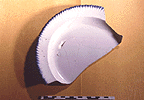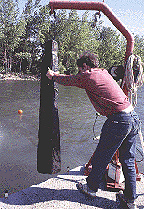Glossary
Back to "Artefacts"
Homepage
How Were the Artefacts Found



The artefacts from the wreck of the P.S. Lady Sherbrooke may be generally grouped into two categories. The first group includes those objects directly associated to the vessel itself, such as pieces of wood, iron, or other material. Secondly, there are those objects that are linked to the persons or materials that were transported by the ship. This second grouping includes a variety of wine and beer bottles, dinner plates, mechanics tools, pieces of shoes, and a list of other types of objects that identify how time was spent on board and what the level of comfort was for passengers and crew. To allow for an understanding both of the vessel and those who used a careful recording of where and how the artefacts were recovered was kept by the researchers.
The task of bringing any artefact to the surface first involved a diver evaluating the best approach to raise the object, and then the actual surfacing of the artefact. Smaller artefacts were generally raised with the suction pumps that the divers directed over the area of the wreck. Included with the thousands of gallons of water pumped through the recovery screens with smaller objects ranging from very thin plate glass to some coins, buttons, and coal. A frequent examination of the screens was required to retrieve as many of these smaller artefacts as possible.
Larger objects, such as pieces of the actual ship, required more attention to ensure a safe raising of the object to the surface. Keeping in mind the weight of an object such as a large section of the stern, which was made from solid oak and had been in water for over 150 years, safety precautions were necessary so that no one's safety was placed in peril. A small crane, on board the research vessel the John Molson II, raised several of the larger pieces of wood once they had been drawn in situ (at the actual original location) before removal.
In total an estimated 5,000 artefacts were brought to the surface for examination. Many of these objects, including nearly all of the wood which would have been lost to the elements if they remained on the surface, were returned to their original place of rest in the Saint-Lawrence River. The discovery of these objects has provided several clues in recreating the story of steamship travel in nineteenth century Canada


